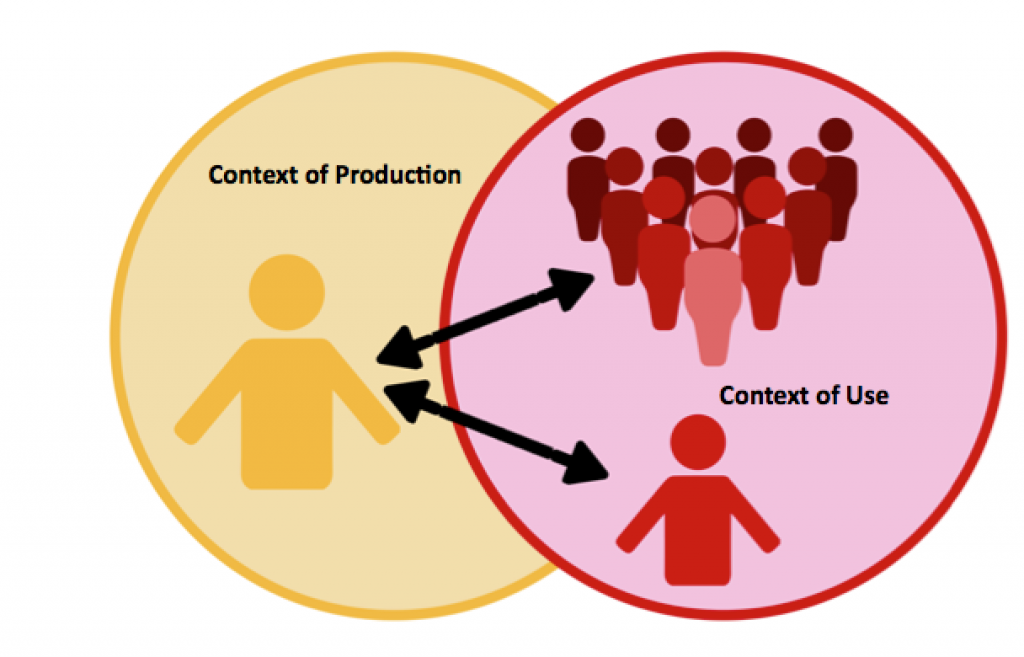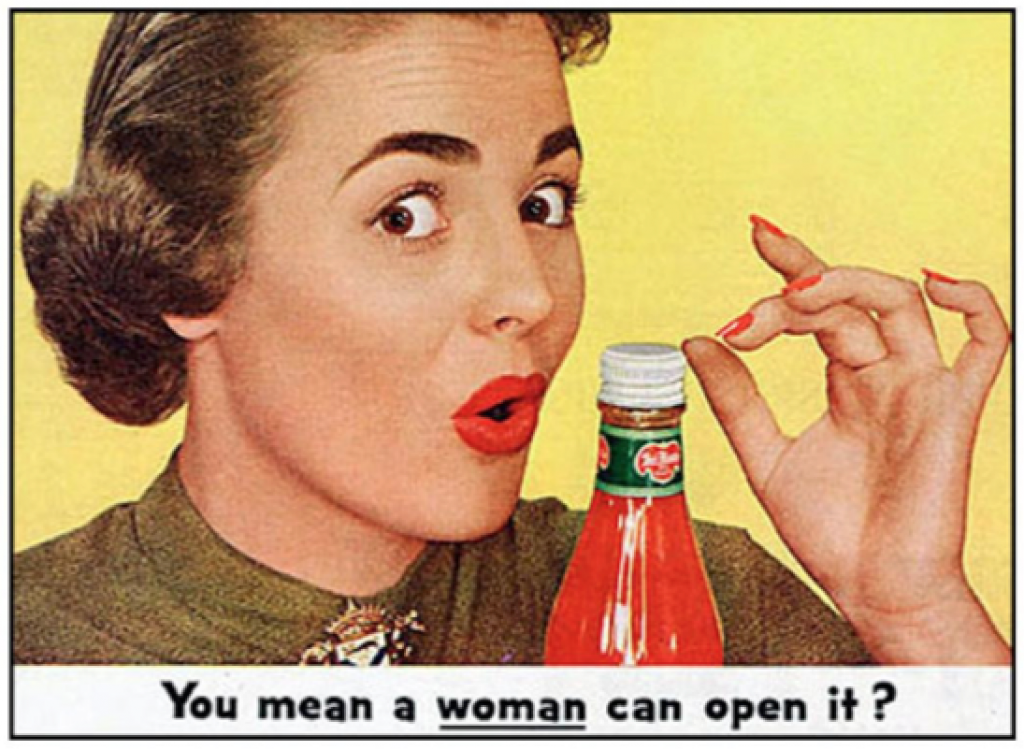The Communication Process
When communication scholars first started studying communication, they saw it as a straightforward process: a sender sends a message to a receiver. The receiver receives it. This model makes the receiver very passive. If this model was true, miscommunications would rarely occur. Today, communication scholars know that what’s happening is more complicated.
In 1948, C.E. Shannon proposed a more complicated theory, which I’ve simplified below.[1]. The main point, however, is that a lot of factors influence and interfere with communication.
Fig. 3.1: Context of Use and Context of Production

3) Use: The audience (in red) doesn’t just passively receive the message. Instead, they decode the message based on their own Context of Use. They draw on their own beliefs, attitudes, experiences, feelings, background, etc. to understand the message. The more these two circles overlap, the more meaning is created.
But not everyone within a culture has the same beliefs and experiences, and many of us go between cultures. For example, an international student from India might behave one way with friends in India, another way when socializing with other international students from India while in Canada, and a third way when interacting with domestic students who have South Asian heritage.
To understand this model better, let’s take a look at this vintage ad for ketchup:

Sometimes it’s easiest to see the Context of Production when we look at a context that’s very different from our own. This ad was created in the 1950s, almost 70 years ago. It was created in a very different context. What kind of values, beliefs and assumptions led to the creation of this ad? Who do you think created it? Who was it marketed to?
When you look at the ad, think about what’s in it and what’s not in it. Judging by the caption, we can probably make some assumptions about how North American society in the 1950s viewed women. To put this ad in perspective, women in Canada weren’t allowed to own a credit card until the 1970s; the first woman officially ran a marathon in the late 1960s. We can assume that this message was produced at a time when the dominant cultural view was that women are weak. In fact, this ad is actually marketed to women (who did the majority of the grocery shopping), so many women saw themselves this way too.
We can also think about what’s not in it. The woman in the ad looks very stereotypically feminine (red fingers and nails, dress, etc.) and we can assume that she’s maybe middle class or upper class by her jewelry. She’s also white; it’s likely that this ad was created by white people with the intended audience of white people. That’s not surprising. Around the time this ad was created, Canada had just allowed people of Japanese, Chinese and South Asian descent to vote and when these groups were depicted in advertisements, they were racist caricatures. (In fact, Indigenous people were not allowed to vote in Canada until 1960). That ad is encoded with a Context of Production that saw women as weak, that valued a particular type of femininity, and that ignored or discriminated against BIPOC (Black, Indigenous, People of Colour), and the ad reflects that.
This ad was probably circulated in magazines at the time. Imagine seeing this ad in a magazine. The bright yellow would likely stand out in contrast to the red ketchup bottle, fingernails and lips and catch your attention. Sometimes, ads like this one were accompanied by recipes that used ketchup. People (mostly women) could cut out the recipes and add them to their recipe box. This ad is therefore designed to be circulated in a particular way.
Today, however, the Context of Use is very different. How do you think a modern North American audience would react to this ad? They might be insulted. That’s because they’re decoding the ad in a society where women do Crossfit and lift weights, and would not see themselves as being too weak to open a ketchup bottle. You’re also seeing this ad in a textbook or on a computer screen or mobile phone, which is something that the creators of this ad couldn’t have even dreamed of. Maybe you’re new to Canada and you don’t know much about Canadian politics or history. Still, your individual Context of Use (what people in your family and culture think about women, your own experiences, etc.) will determine how you reacted to the ad.
When this ad was created, the creators hoped that it would make people go out and buy ketchup. They obviously weren’t thinking that their ad would be reproduced in this textbook. By including this ad as an example, I’m using it for my own purposes: to teach you about a communication model. You might further reproduce it by remixing it for a project or showing it to a friend.
Because the Context of Use is so different from the Context of Production, there’s not a lot of overlap between the two circles. We can read the message, but it probably doesn’t make us want to buy ketchup. In the 1950s, there would have been much more overlap.
The benefit of studying this communication model is that it helps us to see how our own worldview influences how we communicate. Often, communicators do a lot of work analyzing their audience, but they forget to think about how their own assumptions and values influence how they communicate. A lack of self-reflection can lead to miscommunication and even cause harm to your audience. This is especially important when you are communicating with people of other cultures. As intercultural communication scholar E.T. Hall said, “Years of study have convinced me that the real job is not to understand other cultures, but to understand our own.” (Hall, 1973) This model helps us understand how our own culture influences how we judge other people.
To test your understanding of the model, explore it by clicking on hotspots on the image.
Image Description
Figure 3.1 image description: This model describes the context of use and context of production. There are two overlapping circles: one yellow and one red. The first circle represents the speaker’s context of production. The second represents the context of use that the audience decodes the message in. Because there’s overlap, there’s understanding. [Return to Figure 3.1]
- http://math.harvard.edu/~ctm/home/text/others/shannon/entropy/entropy.pdf ↵
- Agboka, G. (2012). Liberating Intercultural Technical Communication from “Large Culture” Ideologies: Constructing Culture Discursively. Journal of Technical Writing and Communication, 42(2), 159–181. https://doi.org/10.2190/TW.42.2.e ↵

